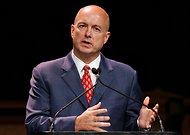Robert Christie, senior vice president of corporate communications for The New York Times Company, is leaving the company and his position is being eliminated, The Times announced Wednesday.
In a memo to the staff Mark Thompson, the company’s chief executive, credited Mr. Christie with building up the Times’s communications team, one he said would “continue to serve The New York Times Company after Bob leaves.” He added that Eileen Murphy, vice president of corporate communications, will now lead the department.
“Bob’s extensive experience and broad range of contacts in the industry have been very valuable over the past three years,” Mr. Thompson wrote.
Mr. Christie, who joined The Times from The Wall Street Journal in 2010, is part of a series of layoffs and buyouts that have been taking place at the company in recent months. In December, Scott Heekin-Canedy, another senior executive, retired, and the company said it would eliminate his position. In December, The Times started to offer buyout packages to 30 members of the newsroom who do not belong to the Guild. Employees volunteering to take these buyouts must accept them by next week.
Article source: http://mediadecoder.blogs.nytimes.com/2013/01/16/times-communications-executive-is-leaving/?partner=rss&emc=rss



